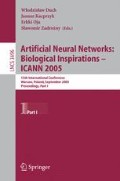Abstract
We present an architecture for the online learning of object representations based on a visual cortex hierarchy developed earlier. We use the output of a topographical feature hierarchy to provide a view-based representation of three-dimensional objects as a form of visual short term memory. Objects are represented in an incremental vector quantization model, that selects and stores representative feature maps of object views together with the object label. New views are added to the representation based on their similarity to already stored views. The realized recognition system is a major step towards shape-based immediate high-performance online recognition capability for arbitrary complex-shaped objects.
Access this chapter
Tax calculation will be finalised at checkout
Purchases are for personal use only
Preview
Unable to display preview. Download preview PDF.
References
Arsenio, A.: Developmental learning on a humanoid robot. In: Proc. IJCNN 2004, Budapest (2004)
Bekel, H., Bax, I., Heidemann, G., Ritter, H.: Adaptive Computer Vision: Online Learning for Object Recognition. In: Rasmussen, C.E., et al. (eds.) Proc. DAGM 2004, pp. 447–454. Springer, Heidelberg (2004)
Fukushima, K.: Neocognitron: A self-organizing neural network model for a mechanism of pattern recognition unaffected by shift in position. Biological Cybernetics 36(4), 193–202 (1980)
Tanaka, K.: Inferotemporal cortex and object vision: stimulus selectivity and columnar organization. Annual Review of Neuroscience 19, 109–139 (1996)
Steels, L., Kaplan, F.: AIBO’s first words. the social learning of language and meaning. Evolution of Communication 4(1), 3–32 (2001)
Wersing, H., Körner, E.: Learning Optimized Features for Hierarchical Models of Invariant Object Recognition. Neural Computation 15(7), 1559–1588 (2003)
Author information
Authors and Affiliations
Editor information
Editors and Affiliations
Rights and permissions
Copyright information
© 2005 Springer-Verlag Berlin Heidelberg
About this paper
Cite this paper
Kirstein, S., Wersing, H., Körner, E. (2005). Online Learning for Object Recognition with a Hierarchical Visual Cortex Model. In: Duch, W., Kacprzyk, J., Oja, E., Zadrożny, S. (eds) Artificial Neural Networks: Biological Inspirations – ICANN 2005. ICANN 2005. Lecture Notes in Computer Science, vol 3696. Springer, Berlin, Heidelberg. https://doi.org/10.1007/11550822_76
Download citation
DOI: https://doi.org/10.1007/11550822_76
Publisher Name: Springer, Berlin, Heidelberg
Print ISBN: 978-3-540-28752-0
Online ISBN: 978-3-540-28754-4
eBook Packages: Computer ScienceComputer Science (R0)

